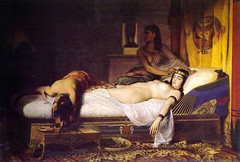It’s time for Icon of Erotic Art #29
Death of Cleopatra (1658) by Guido Cagnacci
“Her sole vestment was the linen shroud that had covered her upon her state bed, and the folds of which she drew over her bosom as if she were ashamed of being so little clothed, but her small hand could not manage it. It was so white that the colour of the drapery was confounded with that of the flesh under the pale light of the lamp. Enveloped in the delicate tissue which revealed all the contours of her body, she resembled an antique marble statue of a bather…Dead or living, statue or woman, shadow or body, her beauty was still the same; only the green gleam of her eyes was some what dulled, and her mouth, so purple of yore, had now only a pale, tender rose-tint almost like that of her cheeks.” –“One of Cleopatra’s Nights” by Théophile Gautier
More by Cagnacci, my first exposure to this celebrator of deviant tastes:
Another “Death of Cleopatra” by Cagnacci
“Magdalena Fainted” by Cagnacci
A lovely chiaroscuro by Cagnacci
To conclude another rendition, by French artist Jean-André Rixens
Death of Cleopatra (1874) by Jean-André Rixens
Tip of the hat to Edward Lucie-Smith‘s Sexuality in Western Art, 1991.






As I explained recently to an old friend, I got interested in art history at the age of fifteen because I liked looking at sexy pictures of women! Okay, I was a bit cerebral, and I liked my turn-ons to tickle my brain too. Who can blame me.
Who says those Victorians were uptight!? They just had different notions of what was proper to do in public – they knew what was what! Peter Gay has mined this theme extensively in his scholarship, albeit with a Freudian program.
Academic eroticism used to be derided as worthless kitsch, althoughthe non-Academy work of the British Pre-Raphaelites has always been valued. The pendulum has swung the other way so that some of the worst of it is now treated seriously, but these examples you post here are wonderful.
Consider a man like W.A. Bouguereau, about whom, I think, you have made some favorable comments. I would agree with my teacher who said of him, “Great painter, lousy artist.” His paintings are boring – a poor follower of Ingres. Not these.
BTW, perhaps you know of Walter Pater? I am sure you would find him of interest.
How come some of my comments get moderated, and others don’t? Is it because I sometimes include links?
Lichanos,
Yes including several links sets off the spam-alarm. I’ve approved you comment. Diana [1]seems to be too diminutive for my tastes.
J